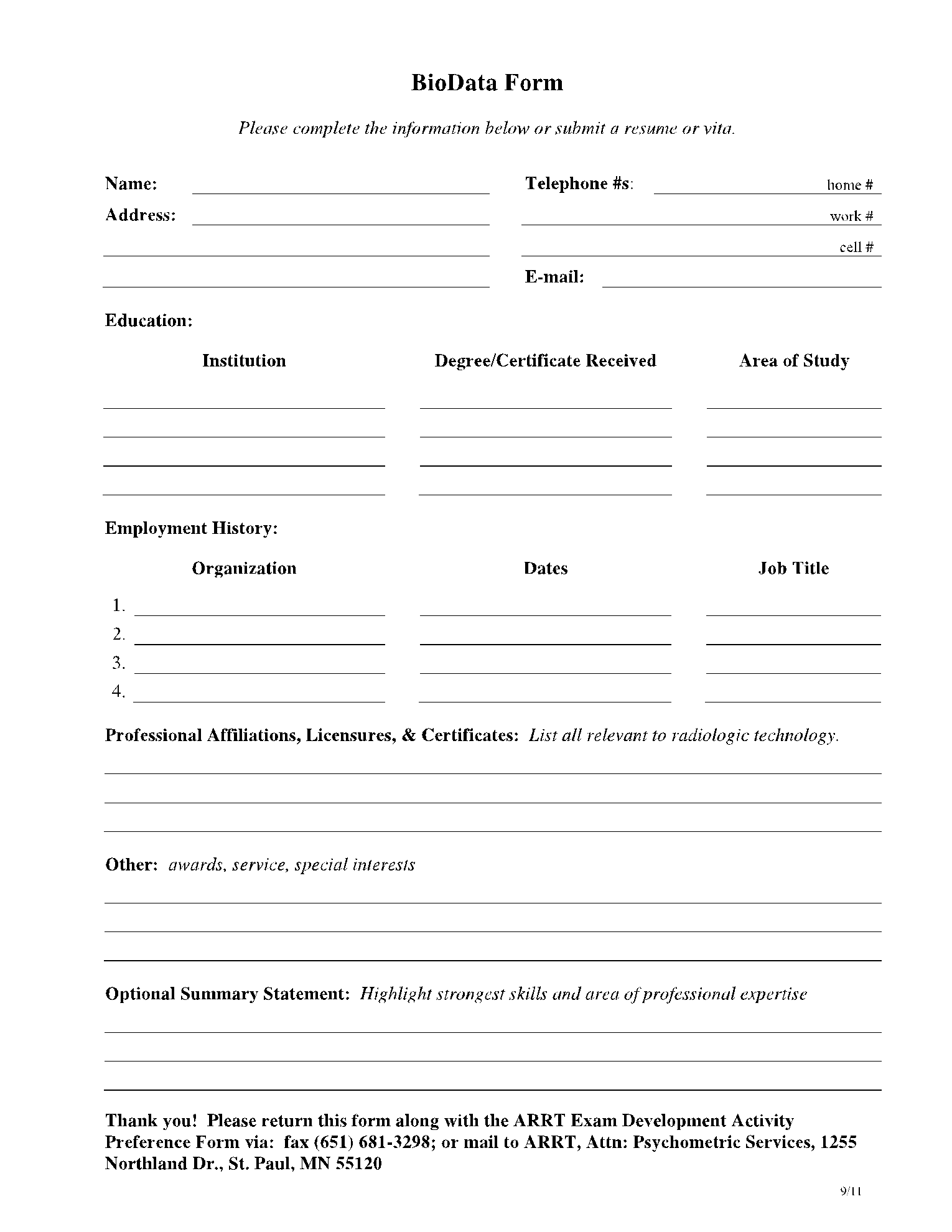
A biodata form is a one-to-three-page document that highlights important details about one’s self. It’s usually used in employee onboarding processes, and contractor-subcontractor relationships, etc.
The word ‘biodata’ itself is coined from 'biographical data'. Therefore, a biodata form typically contains a range of fine details about an individual including name, sex, age, height, nationality, color, etc. There are different types of biodata forms, all of which require a set of unique details.
CocoDoc has a stylish, comprehensive biodata form designed to suit specific purposes like job applications, medical documentation, marriage, and student admission processes. You can fill and sign it online via our platform for free.
A biodata form can’t be used in place of a curriculum vitae (CV) or resume even for job applications. They are different in every sense. Essentially, this is what should be covered in a biodata form:
General information: Every biodata form should have a general/personal information section where the applicant writes out their names, date of birth, address, nationality, and indicates their gender. The date of birth may be in the format DD/MM/YYYY or MM/DD/YYYY. In the nationality field, the user is required to enter the country they have legally naturalized into or their place of birth.
Next of Kin : The individual closest to you and who should be the first point of contact in the case of an emergency is referred to as next of kin. The name of this individual should be written out in full in this section.
Educational background: In this section, the user is expected to put out their academic portfolio and write out their academic achievements. However, these educational achievements should be relevant to the job position applied for.
Experience: This is an important entry in job biodata. The applicant is expected to profile the jobs they’ve done, skills they’ve developed over time, certifications they’ve obtained, professional awards, professional bodies they belong to, and all other work experience related information. In the case of where you have worked, this should be written in chronological order starting from your most recent place of employment.
Lifestyle: This is included in marriage biodata forms to give the intending couple an idea of their partner’s hobbies, likes, dislikes, and religion.
Objective: This is a regular feature in job biodata. It is a paragraph of 2-3 sentences describing how the applicant fits the position they are applying for. It is an ample opportunity for newcomers who have little to no experience to present their strongest qualities, and how they can serve the company in their capacity.
The previous section dealt extensively with what should be covered in a biodata form. Here’s a step-by-step guide on how to fill one.
First, enter your names in full in the highlighted space provided on the form. You are also required to provide your address. As shown in the biodata form below, you will provide your address for communication, present and permanent addresses respectively. Finally, you are required to enter your telephone number and email.

Next, enter the names of institutions you have attended and the corresponding degree or certificate received from this institution. What was your area of study? Indicate this in the area of study field. Typically, the most recent is listed first and on, in that order.

List all professional affiliations, licensures, certificates, awards, services, and special interests relevant to the job position you are applying for. Finally, provide a 2-3 summary statement exemplifying you, what you represent, your strengths, and your area of professional expertise. Your summary statement should be sharp and concise.
 and special interests relevant to the job position " />
and special interests relevant to the job position " />
The uses of a biodata form include;
Fact - finding : A biodata form is useful in finding facts about you to indicate that you are who you say or claim to be. Examples of these include your names, age, residential address, and social security number among others.
Profiling : The contents of a biodata form including their height, hair and eye color, or hobbies can be used to profile an individual.
Evaluation : The information provided and used in profiling you can be vital in predicting your tendencies and likely actions. When combined with your medical history, in the form of a medical biodata, evaluation of your personality traits and tendencies becomes even easier.
There are many reasons why you may need to complete a biodata form, depending on the type of biodata that is requested.
Couples : In countries like Pakistan and India where arranged marriage is still a thing, it is common practice for the individuals getting married to turn in a marriage biodata. The biodata form is supposed to highlight the user’s life goals, lifestyle, and partner expectations so each individual knows more about their intended partner.
Medical facilities : You may be required to complete a medical biodata by a medical facility as part of its background check for patients visiting their facility. The information provided may be useful in determining the course of medical action required and ascertaining your medical history.
Organizations : An organization may require you to provide biodata either as part of its recruitment and employee onboarding process or for record-keeping of its workers (employee details).
Student admission : If you are a student, then you fall into one very important category of individuals who need a biodata form. Typically, during the medical screening process, you are required to submit a biodata which gives the school’s medical personnel a brief idea of who they are dealing with. It also gives them salient information concerning your age which may influence what medication they prescribe for you in the case of an emergency.

Download PDF Fill Out Form